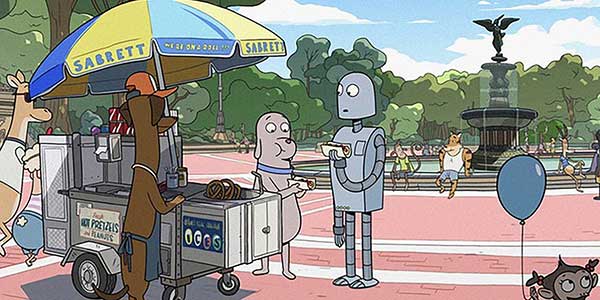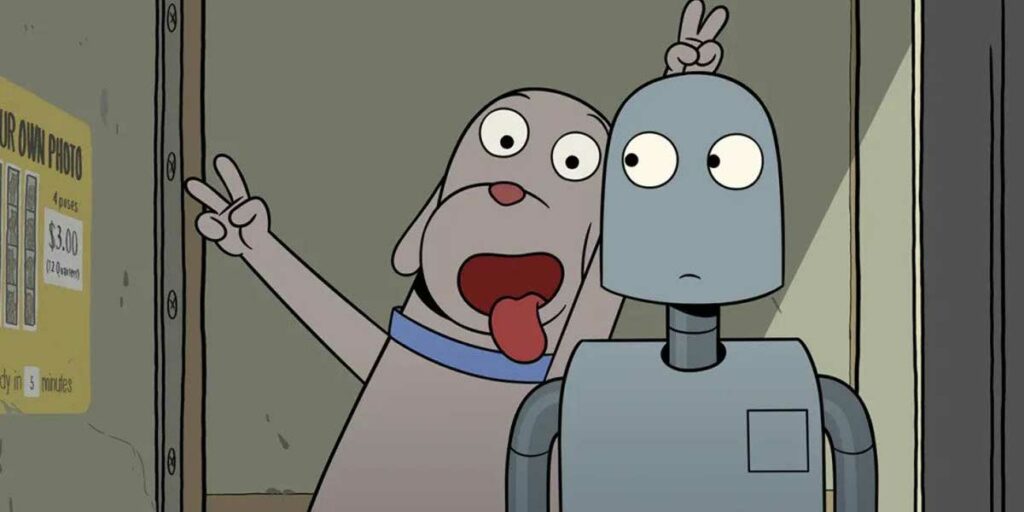Robot Dreams is an unexpected but appropriate career change for director Pablo Berger, who captures the art of silent cinema brilliantly.
Pablo Berger is one of the last great masters of visual storytelling working in film today. His work on the modern classic Blancanieves is a brilliant showcase on how to make a movie in the modern age with no dialogue. While he had never directed an animated movie before, collecting graphic novels changed his mind. After reading Sara Varon’s comic book “Robot Dreams,” Berger was moved to tears and decided to turn it into a movie. In collaboration with several animators across France and Spain, Berger crafted a 102-minute moving spectacle of love and loss with zero dialogue.
In an alternate 1980s New York where all residents are human-like animals, a lonely dog decides to create a robot for himself as a companion. The two become inseparable, and bond over a sequence of many different activities. Then, one day at the beach, the robot rusts and the dog is helpless to save him. The beach will not open for months, so both dog and robot are left to grieve over each other while waiting for the chance to reunite. Though brief, the moments between the pair are quite moving and playful, and the feel given for the two makes their separation all the more painful.
Despite being a program created to service the dog, the robot himself has a distinct personality. All of the characters are given some facial features and distinguishing traits to make up for the lack of dialogue. A world where everyone is an animal takes advantage of having animals by giving them animal traits to remind viewers how they are not human. At one point, the dog uses his enhanced sense of smell to further the plot along, and the way it is handled feels just right for this setting. Jokes are told through visuals like slapstick or character expressions. Eyes widen and mouths move in ways that can only work through animation, and every moment feels earned with them.
Robot Dreams lives up to its title by understanding the power of dream sequences. Moments involving robot and dog being reunited or one of them creating a new partner pass by and progress in a natural-feeling matter. But just as it feels too good to be true, snap back to reality and we see it is. These sequences feel like dreams, blending reality and making us question what we saw in prior scenes leading up to the events. The inevitable moments where the characters wake up are marked by shifts in scenery and score, making the audience feel like they woke up with them.

These dreams lead to clever scene transitions and many elaborate production numbers, calling back to classic musicals like The Wizard of Oz or the films of Busby Berkeley, giving much needed levity for such a depressing situation as separation anxiety. All of this makes the movie surreal in the most basic sense of the word, projecting and illuminating dreams onto its audience. Plus, the robot rusting on the beach calls to mind sleep paralysis, an all too common fear for many people and an appropriate display for a movie all about dreams.
The nature of the relationship between robot and dog is broad enough to be interpreted in a number of ways. This is appropriate, as regardless of the types of relationships we people have in life, they end unexpectedly and without warning. Parting is rarely easy, and the process for all parties involved will be different. It is important to treasure memories, find comfort and support, and learn to let go. The film’s use of “September” by Earth, Wind and Fire, a song all about memories and capturing nostalgia for being with someone else, is a brilliant choice, and its ample play throughout the movie hammers home the main themes. The story takes many unexpected turns with the final fate of these two characters and as the tides turn, their separation only grows greater with time. Without spoiling too much, Robot Dreams does not end as one would expect a film of this genre to end.
Robot Dreams is both hilarious and depressing. It captures all the hallmarks and realities of moving on, longing and letting go, and processing emotion during any separation. Any dialogue or narration would feel redundant and superfluous, with all the story needing to be told being through motion and expression. There are moments to laugh, moments to cry, and sections to ponder on how the story got to where it did, much like life itself. While a simple story, it does not overstay its welcome and manages to be an enjoyable tale for those who love animation and visual storytelling.
Robot Dreams premiered at TIFF on September 12, 2023 and will be released in US theaters on May 31, 2024. Read our list of films to watch at the 2023 Toronto Film Festival!

